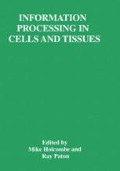Abstract
Biocomputation involves studying organisms using the metaphor of computers so we can discover both new ways of performing computation and defining living systems. An appropriate point to start any discussion of biocomputation is by contrasting the distinct properties of computers and biological systems. Only then is it possible to consider the concept of computation and whether some of the activities of both systems lie within our definition. As computers are man-made their properties are easily described: computers process symbolic information; they solve mathematical problems by algorithms. Physically they are composed of large, regular arrays of interconnected switches so that their component parts can interact in strictly controlled ways. This arrangement, called structural programmability, [Con85], gives computers the capability of simulating one symbol processing machine on another. The primary way of performing this simulation is recursion and sequence.
Access this chapter
Tax calculation will be finalised at checkout
Purchases are for personal use only
Preview
Unable to display preview. Download preview PDF.
References
N. Arber, G. Zajicek, and I. Ariel. The streaming liver II: Hepatocyte life history. Liver, 8:80–87, 1988.
Michael Conrad. On design principles for a molecular computer. Communications Of The ACM, 28(5):464–480, 1985.
Michael Conrad. Molecular computing: The lock-key paradigm. IEEE Computer, 25(11):11–20, 1992.
Nicola Dioguardi. The Liver, The Hepatone and Its Functioning. Universita degli Studi di Milano, 1995.
Manfred Eigen, W. Gardiner, P. Schuster, and R WinklerOswatitsch. The origin of genetic information. Scientific American, 244(4):78–94, 1981.
Manfred Eigen. Self-organization of matter and evolution of biological macromolecules. Naturwissenschaften, 58:465–522, 1971.
Gail Raney Fleishaker. Autopoiesis - the status of its system logic. Biosystems, 22(1):37–49, 1988.
George Kampis. Self-modifying Systems In Biology And Cognitive Science. Pergamon Press, 1991.
George Kampis. Life-like computing beyond the machine metaphor. In Ray C. Paton, editor, Computing With Biological Metaphors. Chapman And Hall, 1994.
Arthur Koestler. The Ghost In The Machine. Arkana/Penguin Books, 1967.
R. Levins. Complex systems. In C. H. Waddington, editor, Towards A Theoretical Biology, volume 3, pages 73–88. Edinburgh University Press, 1970.
Ray C. Paton, H. S. Nwana, M. J. R. Shave, and T. J. M. Bench-Capon. Computing at the tissue/organ level. In F. J. Varela and P. Bourgine, editors, Towards a Practice of Autonomous Systems, pages 411–420. MIT Press, 1992.
Ilya Prigogine and Isabelle Stengers. Order Out Of Chaos: Man’s New Dialogue With Nature. Flamingo, 1985.
Robert Rosen. Some relational cell models: The metabolism-repair systems. In Robert Rosen, editor, Foundations Of Mathematical Biology, volume 2, pages 217–253. Academic Press, New York, 1972.
Stanley N. Salthe. Development And Evolution: Complexity and change in biology. MIT Press, 1993.
W. Richard Stark. Artificial tissue models. In Ray C. Paton, editor, Computing With Biological Metaphors. Chapman And Hall, 1994.
Francisco J. Varela. Principle of biological autonomy. North Holland, 1979.
E. R. Weibel. The non-statistical nature of biological structure and its implications on sampling for stereology. In Lecture Notes in Biomathematics: Geometrical Probability and Biological Structures, volume 23. Springer Verlag, Berlin, 1977.
Norbert Wiener. Cybernetics: or control and communication in the animal and machine. MIT Press, 1953.
Author information
Authors and Affiliations
Editor information
Editors and Affiliations
Rights and permissions
Copyright information
© 1998 Springer Science+Business Media New York
About this chapter
Cite this chapter
Butler, M.H., Paton, R.C., Leng, P.H. (1998). Information Processing in Computational Tissues. In: Holcombe, M., Paton, R. (eds) Information Processing in Cells and Tissues. Springer, Boston, MA. https://doi.org/10.1007/978-1-4615-5345-8_19
Download citation
DOI: https://doi.org/10.1007/978-1-4615-5345-8_19
Publisher Name: Springer, Boston, MA
Print ISBN: 978-1-4613-7438-1
Online ISBN: 978-1-4615-5345-8
eBook Packages: Springer Book Archive

